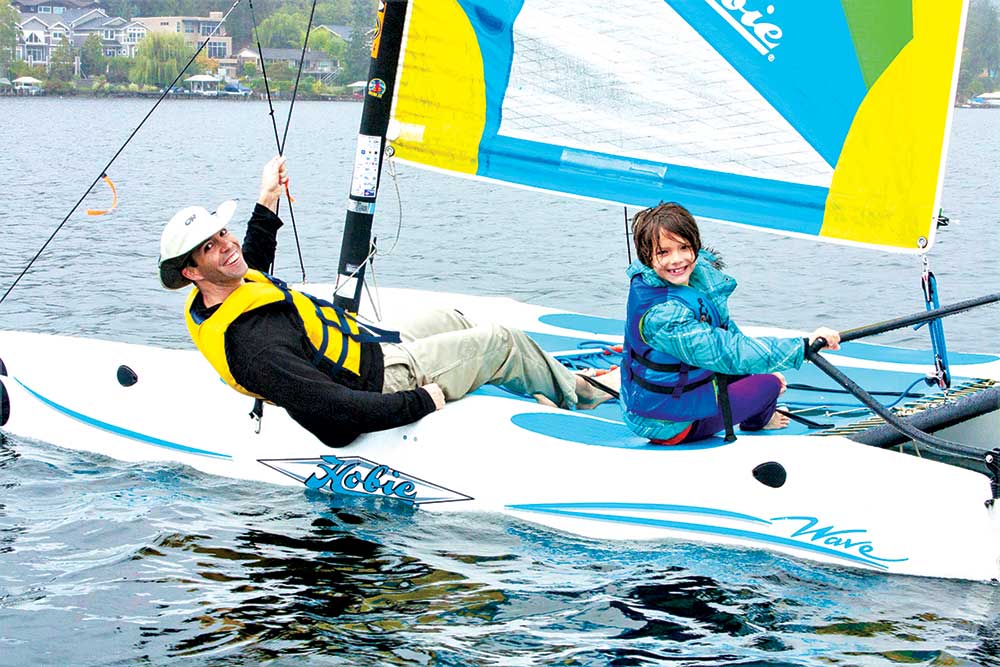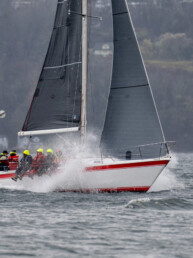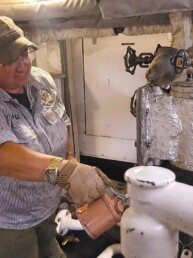As we gratefully celebrate Andrew Nelson’s tenure as Youth Sailing Director at The Sailing Foundation, here’s one of our favorite articles he wrote for us contextualizing and seeking to strengthen youth sailing.
This article was published in the February 2016 issue of 48° North.
Some of my fondest memories growing up were sailing with my dad and the crew of the Cal 40, White Squall. It wasn’t about winning, but having fun and spending time with my extended “boat family.” Eating mildly warm beef stew out of mug and sleeping aboard the night before the race were all part of the experience. Fewer and fewer junior sailors come from sailing families or have access to boats outside of class hours. That means most of today’s young sailors never get to enjoy sailing with their parents, but there are plenty of junior sailing programs trying to reverse this trend and get families on the water together.
To the increasingly busy American family, junior sailing is often just one more stop on the minivan’s route to work. At the end of the day, sailors are whisked away, perhaps changing in the car as the family rushes Suzy to her soccer game. At the end of the week- long “learn to sail” program, little Suzy goes home and puts her completion certificate on the refrigerator. There it hangs next to the other awards she earned from rock climbing, jujitsu, and math camp. Next week she’s off to a week-long music camp.
It’s hard for an activity to stick when it’s just one of many that a child is constantly bombarded with. Sure there are those children who get really excited about sailing and want to do nothing else, but they are the exception. And in the world of junior sailing we rely heavily on these exceptions! However, if we really want to develop more lifelong sailors we need to engage children and parents together, so that sailing becomes more than just another activity, sailing becomes family time. How is this possible when most junior sailors come from families that don’t sail?
This takes some creativity on the part of junior sailing programs, and depends largely on what resources they have at their disposal and how much flexibility they have in their schedule to add additional events and activities. Sail Sand Point, for example has been very successful with their “Mommy (or Daddy) and Me” sailing course, where parent and child learn to sail together on a small boat. This is an empowering experience for the young sailor who often teaches mom a thing or two along the way. Graduates of “Mommy (or Daddy) and Me” can take advantage of Sail Sand Point’s rental program and go sailing together on their own time, making it a special experience they can continue to share long after the course is over. With Sail Sand Point’s affordable rental rates, their family doesn’t have own a boat to be part of the sailing community.

Family nights and weekly barbeques are another great way to get parents on the water. When I worked at Balboa Yacht Club in Newport Beach we had a few themed parent nights each summer. They always involved kids taking their parents for a sail. It was comical to watch some of the bigger dads try to squeeze into an 8’ Sabot with their child, but they loved it. Some of the kids drove the entire evening, while others coached their parents as they tried it for the first time. “Dad you’re in the no-go-zone,” you’d hear young sailors exclaim. The expression of parents returning to the dock was priceless. “How do they know all that stuff?” The pride radiating from the young sailors was evident too. “Tonight I taught my dad something he didn’t know.”
With the aging and declining membership of many yacht clubs, junior sailing is also a great way to bring in new blood. When I worked at Encinal Yacht Club in the Bay Area, we had about a dozen families join each year and most had no prior sailing experience. Many of these families soon became sailing converts, either through our adult sailing lessons, which we taught on J/24s, or by going out and sailing with other members. I can think of several families that became sailing converts before the family expert lost all their baby teeth. Social ties were reinforced through volunteer activities and events. New parents were paired up with experienced parents to help move marks or record finishes at junior regattas. The fact that a fair number of these families remained members after their kids moved off to college was proof that they had adopted the sailing community as their own. It’s also no coincidence that the children of these families almost invariably kept sailing after graduation. Some went on to excel as college sailors, while others came back year after year to instruct at the junior program. Involving kids and parents strengthens their ties to sailing, by providing a shared experience they can both keep coming back to.
I can understand the apprehension in the youth sports community (not just sailing) of welcoming parents with open arms and asking them to get more involved. It’s unfortunate that the actions of a few overbearing or hyper-intense parents give the other ninety-nine percent a bad rap. Yes, as a program director I’ve been cussed out, threatened, and told-off by a handful of parents, so I can understand why the trend in youth sports is to put up more boundaries. In extreme cases I’ve even seen “No parents allowed beyond this point” signs. It’s true that parents shouldn’t interrupt instructors while they’re teaching or rig their child’s boat for them, but in the long run it’s damaging to shut parents out of a sport like sailing which can be such a great family activity. The trick is to channel parent energy in a constructive manner, instead of leaving parents on the sidelines. Family nights, weekly barbecues, and adult sailing lessons are all positive outlets for those parents who want to get involved, but might not otherwise know how. It’s no surprise that some of the top junior sailing programs are those that make the extra effort to get kids and parents on the water together.
I got a rare chance to link up with my extended “boat family”for the Duwamish Head race. White Squall is in the cruising class now and the dodger stays up year round, but I was reminded of why I fell in love with sailing in the first place. Before pushing off the dock I saw young Dieter Creitz carrying a sail that weighed as much as him, along with his father Nate. At age nine, Dieter [2022 update: Dieter is now the RS Aero 5-meter-Rig World Champion] sails and competes year round in his Opti, but that morning he joined his mother, father and grandfather for the race. Three generations were present aboard Flim Flam, which belongs to Nate’s father Fred. During frostbite races at Shilshole it’s not uncommon to see Nate’s Aero rafted up to Dieter’s Opti between starts. Some nine year olds might get burned out with that much sailing, but for Dieter it’s very much a family activity that both he and his parents enjoy.
When you come from a sailing family, it’s easy to take experiences like those for granted. For those of us that teach sailing and work with youth, we need to make a conscious effort to involve parents… yes, even those who drive us crazy. Sailing competes against a lot of other activities. If we can’t find ways to positively engage parents and families, then junior sailing risks becoming one more minivan stop.
Lastly, if you’re a parent who’s reading this, don’t pass up the opportunity to go sailing with your child! It shows you’re taking a genuine interest in their life, and who knows, you might learn a thing or two.
Thanks for your good work and great perspective, Andrew!






